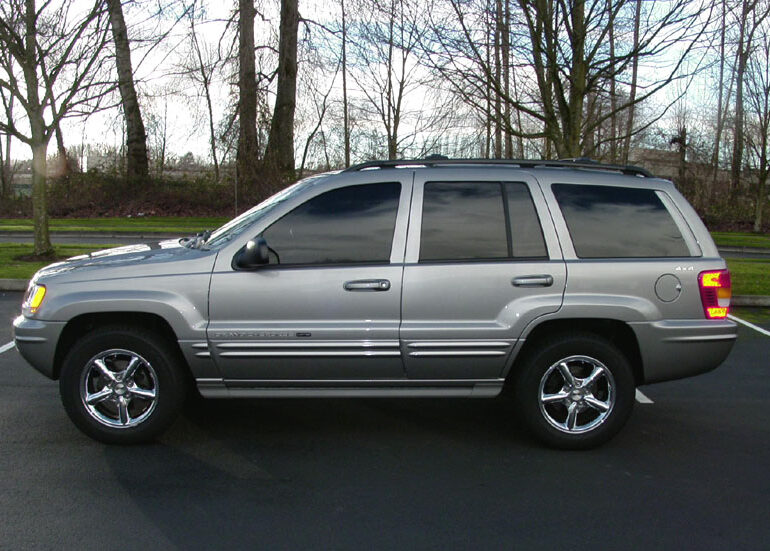Welcome to the JeepSpecs.com in-depth page on WJ Generation Jeep Grand Cherokee towing guide. We have organized as much information as we could find into a helpful article below. Is something incorrect or missing? Please get in touch with us and we’ll fix it!
STANDARD PROCEDURE – TOWING RECOMMENDATIONS
A vehicle equipped with SAE approved wheel lift type towing equipment can be used to tow WJ vehicles. When towing a 4WD vehicle using a wheel-lift towing device, use tow dollies under the opposite end of the vehicle. A vehicle with flatbed device can also be used to transport a disabled vehicle.
WARNING: When towing a disabled WJ vehicle and the drive wheels are secured in a wheel lift or tow dollies, ensure the transmission is in the Park position. WARNING: Ensure vehicle is on a level surface or the wheels are blocked to prevent vehicle from rolling.
|
TWO-WHEEL-DRIVE VEHICLE TOWING
DaimlerChrysler Corporation recommends that a vehicle be towed with the rear end lifted, whenever possible.
Two wheel drive towing – rear end lifted
1. Attach wheel lift device to front wheels.
2. Place the transmission in neutral.
3. Raise vehicle to towing position.
4. Attach safety chains. Route chains so not to interfere with tail pipe when vehicle is lifted.
5. Turn the ignition switch to the OFF position to unlock the steering wheel.
6. Secure steering wheel in straight ahead position with a clamp device designed for towing.
7. Place transmission in park.
Two wheel drive towing – front end lifted
1. Attach wheel lift device to rear wheels.
2. Place the transmission in neutral.
3. Raise the rear of the vehicle off the ground and install tow dollies under rear wheels.
4. Attach wheel lift device to front wheels and raise vehicle to towing position.
5. Attach the safety chains. 6. Turn the ignition switch to the OFF position to unlock the steering wheel.
7. Secure steering wheel in straight ahead position with a clamp device designed for towing
8. Place transmission in park.
FOUR-WHEEL-DRIVE VEHICLE TOWING
DaimlerChrysler Corporation recommends that a 4WD vehicle be transported on a flat-bed device. A Wheel-lift device can be used provided the trailing wheels are off the ground and positioned in tow dollies.
Four wheel drive towing – rear end lifted
1. Attach wheel lift device to front wheels.
2. Place the transmission in neutral.
3. Raise the front of the vehicle off the ground and install tow dollies under front wheels.
4. Attach wheel lift device to rear wheels and raise vehicle to towing position.
5. Attach safety chains. Route chains so not to interfere with tail pipe when vehicle is lifted.
6. Turn the ignition switch to the OFF position to unlock the steering wheel.
7. Secure steering wheel in straight ahead position with a clamp device designed for towing.
8. Place transmission in park.
Four wheel drive towing – front end lifted
1. Attach wheel lift device to rear wheels.
2. Place the transmission in neutral.
3. Raise the rear of the vehicle off the ground and install tow dollies under rear wheels.
4. Attach wheel lift device to front wheels and raise vehicle to towing position.
5. Attach the safety chains.
6. Turn the ignition switch to the OFF position to unlock the steering wheel.
7. Secure steering wheel in straight ahead position with a clamp device designed for towing
8. Place transmission in park.
RECREATIONAL TOWING
CAUTION! Internal damage to the transfer case will occur if a front or rear wheel lift is used then recreational towing.
NOTE: The transfer case must be shifted into N (Neutral) for recreational towing.
A. Shifting Into Neutral (N)
Use the following procedure to prepare your vehicle for recreational towing.
CAUTION! It is necessary to follow these steps to be certain that the transfer case is fully in N (Neutral) before recreational towing to prevent damage to internal parts.
1. Depress brake pedal.
2. Shift transmission into N (Neutral).
3. Shift transfer case lever into N (Neutral).
4. Start engine.
5. Shift transmission into D (Drive)
6. Release brake pedal and ensure that there is no vehicle movement.
7. Shut the engine OFF and place the ignition key into the unlocked OFF position.
8. Shift transmission into P (Park).
9. Apply parking brake.
10. Attach vehicle to the tow vehicle with tow bar.
11. Release parking brake.
CAUTION! Transmission damage may occur if the transmission is shifted into P (Park) with the transfer case in N (Neutral) and the engine running. With the transfer case in N (Neutral) ensure that the engine is OFF prior to shifting the transmission into P (Park) (refer to steps 7 – 8 above).
B. Shifting Out Of Neutral (N)
Use the following procedure to prepare your vehicle for normal usage.
1. Shift transmission into N (Neutral).
2. Shift transfer case lever to desired position.
3. Shift transmission into D (Drive).
NOTE: When shifting out of transfer case N (neutral), turning the engine OFF may be required to avoid gear clash.
WARNING! You or others could be injured if your leave the vehicle unattended with the transfer case in the N (Neutral) position without first fully engaging the parking brake. The transfer case N (Neutral) position disengages both the front and rear driveshafts from the powertrain and will allow the vehicle to move regardless of the transmission position. The parking brake should always be applied when the driver is not in the vehicle.
CAUTION! Do not use a bumper mounted clamp-on tow bar on your vehicle. The bumper face bar will be damaged. Do not disconnect the rear driveshaft because fluid will leak from the transfer case and damage internal parts.

